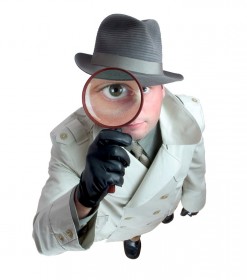The short walk from the car to the restaurant is the mostly forgettable moment before sitting down to what you hope will be a terrific meal. Think about it: If someone were to ask you to recount that brief segment in time, needless to say, you probably wouldn’t have much to offer. After all, it’s just a parking lot, right?
For the man emerging from the passenger’s side though — while his stroll toward the restaurant appears leisurely, he is, in fact, critically observing everything. Is there trash and cigarette butts strewn through the lot? Are the overhead lights all working? Are the parking space lines visible? Is the restaurant’s landscaping presentable? Windows clean? Signage clearly marked? All this and more, and this is just the opening volley of observations he will soon serve up in a concise, ever-telling report.
 This man is a mystery shopper. He is contracted by the restaurant to take in as many aspects of the dining experience as possible, focusing in upon a series of pre-determined and standardized questions, and reporting the results back to the ownership.
This man is a mystery shopper. He is contracted by the restaurant to take in as many aspects of the dining experience as possible, focusing in upon a series of pre-determined and standardized questions, and reporting the results back to the ownership.
This shopper is not a restaurant critic, nor is his goal to be judgmental. “Quite the opposite,” he’ll tell you. “I am not hoping for the staff to make mistakes while I’m here. The most fulfilling reviews are the most positive ones, where everything is nearly flawless — the food is delicious, the staff is friendly and accommodating, and the final analysis shows the restaurant is hitting all its marks. When training is working, and my reports are deemed effective then ultimately, customers’ overall impressions are positively impacted.”
Still, mistakes happen. And they should occur from time to time. Nothing is ever perfect and everyone can stand to improve. “What’s important is for lapses to be observed whenever possible, and thus, duly noted and then corrected.”
 “Having an outsider coming in to check my restaurant, especially when I’m not there, gives me comfort in knowing when problems are happening, or, when things are running better than I thought.” This is coming from “Restaurateur X” (His real name and his dining establishment won’t be revealed here since his staff is not aware of the shopper’s clandestine monthly visits.)
“Having an outsider coming in to check my restaurant, especially when I’m not there, gives me comfort in knowing when problems are happening, or, when things are running better than I thought.” This is coming from “Restaurateur X” (His real name and his dining establishment won’t be revealed here since his staff is not aware of the shopper’s clandestine monthly visits.)
“I’ve heard through the grapevine that some [employees] act differently when I’m not around,” continues Restaurateur X. “The mystery shopping helps to insure uniformity by providing an under-the-radar approach. I learn what’s positive. I can deal with the rest.”
You enter and are met by a host at the podium. “How many?”
“Three.” you reply.
The young man collects menus and leads the party to the table. “Your server will be right with you.” He turns on his heel and departs.
“Well, that went okay,” you say.
“No, not at all” the shopper counters.
“He should have greeted us by saying ‘Hello,’ not ‘How many?’ and he never smiled once. He is supposed to ask if we’ve been here before. He did not identify the server by name, and he never wished us an enjoyable meal.”
Like the edifying walk through the parking lot, you’re now fairly astounded by all of the measures being considered in that one simple greeting and seating procedure.
The waitress though, she’s all-varsity.

After a sunny “Hi!,” a thorough taking of drink orders, recitation of specials and telling you a few of her “personal favorites,” our mystery man rattles off a litany of good vibrations equating to high scores: “She not only gave a big, legitimate introduction, she’s also doing the same with the tables around us. She mentioned and described the specials, and when you asked for a beer, she up-sold you on a craft ale over the cheaper domestic one you were interested in getting. This young lady is really representing the restaurant well.”
You are instructed to look at your table. “Are the salt and pepper shakers, ketchup and hot sauce bottles clean and full?” Check.
“Is there a promotional tent displaying upcoming entertainment?” Check.
“Is the table clean and level?” Uh-oh.
You notice the perceptible wobble.
“And how about the floor, is it spotless? Are the window sills dusty?”
You had never even thought to notice a window sill in a restaurant until this visit.
As the review continues you begin to perceive other aspects that would not have been quite as evident without a professional spotter in your midst. The music is audible but a bit too understated; the room’s temperature feels fine, and all overhead lights are working. Well, almost (a burnt-out bulb is a glaring outage in a nearby darkened corner).
The food arrives on time, hot, pleasingly displayed and it all tastes great. No complaints here. “Doesn’t the menu say your dish is supposed to have chopped scallions? And didn’t you request a slice of lemon?” You had failed to notice these small absences until now.
When there are no staffers in sight you ask, “Aren’t you worried about getting caught?”
“Not at all” is the shopper’s confident reply. “For one thing, unlike amateurs who do this, I avoid asking the server a million questions to try and trip them up. That will make you stick-out…it’s the server who is supposed to ask her customer’s questions and provide the proper information. Also,” he gestures at you and your guest, “I use those I’m dining with as a wall between me and the staff. You two can be more obvious. Me? I’m just the quiet, non-descript guy blending in with the other customers.”
 “The hardest part to this job used to be the act of recording as many observations as possible in a finite amount of time. Picking up every single queue is very challenging. This used to mean I had to frantically scribble notes on a pad hidden underneath the table, or duck into the rest room to jot stuff down so I could remember it. Now, it’s easy. All I need is this—” He produces his smart phone. “No one suspects I’m recording information. Why would they? Practically everyone here is, or will be texting at various points during their meal.” He points his phone’s camera at his entrée and clicks off a shot. “So I can give a good description later,” he explains. “Before smart phones it used to be rude to snap photos in a public space. Now, it’s commonplace.”
“The hardest part to this job used to be the act of recording as many observations as possible in a finite amount of time. Picking up every single queue is very challenging. This used to mean I had to frantically scribble notes on a pad hidden underneath the table, or duck into the rest room to jot stuff down so I could remember it. Now, it’s easy. All I need is this—” He produces his smart phone. “No one suspects I’m recording information. Why would they? Practically everyone here is, or will be texting at various points during their meal.” He points his phone’s camera at his entrée and clicks off a shot. “So I can give a good description later,” he explains. “Before smart phones it used to be rude to snap photos in a public space. Now, it’s commonplace.”
Speaking of the rest room, the shopper asks your female guest to give him a few (discrete) details about the condition of the ladies room while the two of you make your way into its gendered counterpart next door. “It smells fresh and items are stocked. The music is being piped in at the right volume. But look—” He gestures at a crumbled-up pile of hand towels by the overflowing waste can. “That’s how it was when I made my initial visit forty minutes ago.”
After settling the tab, (Mystery Man pays and will bill the restaurant’s owner for reimbursement), the waitress gives all of you a pleasant goodbye. Walking past the host’s stand, the young man is deep in conversation with a coworker. They fail to provide a salutation. “Let me guess, points deducted?” you ask the shopper.
“Being unaware that they are being watched gives me an overall picture,” affirms Restaurateur X. “My customers are coming for a reason and it’s not just the food. It is the atmosphere, the service; seeing properly dressed employees and being at a place where there is no trash on the floor; the windows and doors are continually wiped down; the parking lot is clean, safe and welcoming.”
You take an observant scan outside, seeing the lot with far greater clarity than before.
“No litter, no cigarette butts — looks good.”
The gentleman with you agrees.
And who is this mystery man?
You’ll never tell.
Photographs credited to: Microsoft Office, Life123 & Green Book Blog.



